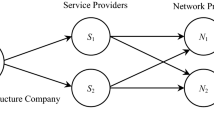Abstract
The telecommunications industry has evolved from voice-centric to provisioning of broadband data services. As witnessed in countries around the world, the industry has an oligopoly market structure with a few operators providing services. The services offered by the operators differ in both price and quality of service. On the other hand, consumers differ in their preferences over price and quality with some displaying sensitivity towards price and others towards quality. In this paper, we provide the standard microeconomic framework of supply and demand for telecom services and derive equilibria under varying supply and demand conditions. In particular, we analyse the strategies of new entrants vis-à-vis incumbents in offering service plans over varying price and quality dimensions. We also analyse the equilibria for varying elasticities of demand of consumers. We then validate the analytical results by simulation using an agent-based model with operator and consumer agents. Our results show that new entrants ought to target relatively elastic consumers as their market entry strategy, by offering a combination of low price, high-quality service plans to gain market share. On the other hand, incumbent operators ought to continue to target relatively inelastic consumers who have loyalty towards them due to larger network effects and associated higher switching costs. Our simulation results also confirm the analytical results. Telecom regulators can use the study results in assessing and regulating (i) market power dynamics of incumbents and new entrants, (ii) tariff plans offered by operators for possible predatory pricing and (iii) quality of service to meet threshold minimum quality of standard levels.



Similar content being viewed by others
References
Noam E M 2006 Fundamental instability: why telecom is becoming a cyclical and oligopolistic industry. Inf. Econ. Policy 18(3): 272–284
Valaskova K, Durica M, Kovacova M, Gregova E and Lazaroiu G 2019 Oligopolistic competition among providers in the telecommunication industry: the case of Slovakia. Adm. Sci. 9(3): 49
Mankiw G 2012 Principles of microeconomics. Delhi: Cengage Learning India Private Limited
Oraedu C 2019 Structural equation test of service quality dimensions on the relationship quality construct: evidence from an emerging telecom market. J. Relatsh. Mark. 18(2): 146–171
Meddeb A 2010 Internet QoS: pieces of the puzzle. IEEE Commun. Mag. 48(1): 86–94
International Telecommunications Union (ITU) 2017 Quality of services regulation manual. Technical Report, International Telecommunications Union (ITU)
Bourreau M, Sun Y and Verboven F 2019 Market entry, fighting brands and tacit collusion: evidence from the French mobile telecommunications market. https://www.ebos.com.cy/cresse2013/uploadfiles/mobile%20entry.pdf.
Neger M, Bhuiyan Md Z H, Chowdhury Md H K and Hossain A 2019 Deterministic modeling for evaluating consumers’ attitude towards telecommunication service in Bangladesh. Bus. Ethics Leadersh. 3(2): 72–82
Sridhar V 2019 Emerging ICT policies and regulations: roadmap to digital economies. Singapore: Springer Nature
Shy O 2001 The economics of network industries, chapter 5, p. 102. Cambridge University Press
Rouvinen P 2006 Diffusion of digital mobile telephony: are developing countries different? Telecommun. Policy 30(1): 46–63
Koski H and Kretschmer T 2004 Survey on competing in network industries: firm strategies, market outcomes, and policy implications. J. Ind. Compet. Trade 4(1): 5–31
Zhang S H and Tang T Y 2019 Managing same-side and cross-side innovations in two-sided platforms. Mark. Intell. Plan. 37(7): 770–790
Abrardi L and Cambini C 2019 Ultra-fast broadband investment and adoption: a survey. Telecommun. Policy 43(3): 183–198
Economides N and Viard V B 2007 Pricing of complementary goods and network effects. New York University Working Paper
Farrell J and Klemperer P 2007 Coordination and lock-in: competition with switching costs and network effects. In: Armstrong M and Porter R (Eds.) Handbook of industrial organization, vol. 3, chapter 31, pp. 1967–2072. Elsevier
Vogelsang I 2013 The endgame of telecommunications policy? A survey. CESifo Working Paper Series 4545, CESifo
Prasad R and Sridhar V 2014 The dynamics of spectrum management: legacy, technology, and economics. New Delhi: Oxford University Press
Chiang M 2012 Networked life: 20 questions and answers. Cambridge: Cambridge University Press
Chen J 2016 How do switching costs affect market concentration and prices in network industries? J. Ind. Econ. 64(2): 226–254
Iimi A 2005 Estimating demand for cellular phone services in Japan. Telecommun. Policy 29(1): 3–23
Fransman M 2002 Telecoms in the Internet age: from boom to bust to?. Oxford: Oxford University Press
Waverman L, Dasgupta K, Nieberding J and Kirkpatrick B 2016 Consumer surplus and the impact of competition for telecommunications services in Bahrain. Berkeley Research Group
Sen S, Joe-Wong C, Ha S and Chiang M 2015 Smart data pricing: using economics to manage network congestion. Commun. ACM 58(12): 86–93
Tellis G J and Wernerfelt B 1987 Competitive price and quality under asymmetric information. Mark. Sci. 6(3): 240–253
Lambertini L and Orsini R 2005 The existence of equilibrium in a differentiated duopoly with network externalities. Jpn. Econ. Rev. 56(1): 55–66
Junior N M D S, Youtang Z, Prestige N L D A and Belinga T 2018 Pricing innovation strategy impact for telecommunication industry companies in Congo Brazzaville based on elasticity analysis. Int. J. Econ. Manag. Sci. 7(517): 2
Bourreau M, Sun Y and Verboven F 2018 Market entry, fighting brands and tacit collusion: the case of the French mobile telecommunications market. CEPR Discussion Papers No 12866
Dang D and Viet D D T 2017 The concentration and competition of Vietnam mobile telecommunications market through HHI and elasticity of demand. VNU J. Sci. Policy Manag. Stud. 33(2): 21–29
Chang S, Kim H, Song J and Lee K 2020 Technological opportunity, technological leadership change, and latecomers’ R&D resource allocation between innovation and imitation. February
Hamill L and Gilbert N 2015 Agent-based modelling in economics. West Sussex, UK: Wiley
Schinckus C 2019 Agent-based modelling and economic complexity: a diversified perspective. J. Asian Bus. Econ. Stud. 26(2): 170–188
Klein D, Marx J and Fischbach K 2018 Agent-based modeling in social science, history, and philosophy: an introduction. Hist. Soc. Res./Hist. Sozialforschung 43(1): 7–27
Parsons S, Rodriguez-Aguilar J A and Klein M 2011 Auctions and bidding: a guide for computer scientists. ACM Comput. Surv. 43(2). https://doi.org/10.1145/1883612.1883617
Vinu Prasad G, Prasad A S and Rao S 2018 A combinatorial auction mechanism for multiple resource procurement in cloud computing. IEEE Trans. Cloud Comput. 6(4): 904–914
Prasad A S and Rao S 2014 A mechanism design approach to resource procurement in cloud computing. IEEE Trans. Comput. 63(1): 17–30
Saaty T L 1980 The analytic hierarchy process, planning, piority setting, resource allocation. New York: McGraw-Hill
Hellmer S 2010 Switching costs, switching benefits and lock-in effects—the reregulated Swedish heat market. Energy Environ. 21: 563–575
Soós G, Ficzere D and Varga P 2020 User group behavioural pattern in a cellular mobile network for 5G use-cases. In: Proceedings of the 2020 IEEE/IFIP Network Operations and Management Symposium (NOMS 2020), Budapest, Hungary, April 2020
Ruutu S, Casey T and Kotovirta V 2017 Development and competition of digital service platforms: a system dynamics approach. Technol. Forecast. Soc. Change 117: 119–130
Baake P and Sudaric S 2019 Net neutrality and CDN intermediation. Inf. Econ. Policy 46: 55–67
Netflix 2020
Fagiolo G, Moneta A and Windrum P 2007 A critical guide to empirical validation of agent-based models in economics: methodologies, procedures, and open problems. Comput. Econ. 30(3): 195–226
Gelenbe E, Seref E and Xu Z 2001 Simulation with learning agents. Proceedings of the IEEE 89(2): 148–157
Tesfatsion L 2006 Agent-based computational economics: a constructive approach to economic theory. In: Leigh Tesfatsion and Judd K L (Eds.) Handbook of Computational Economics, chapter 2, pp. 831–880
Trimborn T, Otte P, Cramer S, Beikirch M, Pabich E and Frank M 2020 SABCEMM: a simulator for agent-based computational economic market models. Comput. Econ. 55(2): 707–744
Sridhar V, Mehta U and Singh R 2017 Need to address quality of service issues. Technical Report, Mint
Telecom Regulatory Authority of India (TRAI) 2017 Measurement of wireless data speeds. Technical Report, Telecom Regulatory Authority of India (TRAI)
Telecom Regulatory Authority of India (TRAI), National Institute of Public Finance and Policy (NIPFP) 2018 Measurement of wireless data speeds. Technical Report, Telecom Regulatory Authority of India (TRAI)
Acknowledgements
The authors would like to thank Ericsson Research for partial support of this work.
Author information
Authors and Affiliations
Corresponding author
Rights and permissions
About this article
Cite this article
Chouhan, A.S., Sridhar, V. & Rao, S. Service provider strategies in telecommunications markets: analytical and simulation analysis. Sādhanā 46, 44 (2021). https://doi.org/10.1007/s12046-020-01535-7
Received:
Revised:
Accepted:
Published:
DOI: https://doi.org/10.1007/s12046-020-01535-7




